
|
Now it is bright as 8.3 mag (Nov. 23, Chris Wyatt). It is observable at 8 mag for a long time from 2022 to 2023. In the Southern Hemisphere, it stays observable for a long time, although it becomes low temporarily from November to December. In the Northern Hemisphere, it is not observable until 2023 summer.
Date(TT) R.A. (2000) Decl. Delta r Elong. m1 Best Time(A, h)
Nov. 26 16 57.87 -51 23.6 2.580 1.822 32 8.0 18:18 ( 43,-24)
Dec. 3 17 12.17 -53 58.5 2.559 1.810 32 8.0 18:18 ( 41,-27)
|
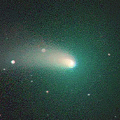
|
Now it is bright as 9.4 mag (Nov. 24, Katsumi Yoshimoto). It will approach to Earth down to 0.29 a.u. in 2023 February, and it is expected to brighten up to 5 mag. In the Northern Hemisphere, it stays observable in excellent condition for a long time, although it becomes extremely low temporarily in November. In the Southern Hemisphere, it is not observable until early February.
Date(TT) R.A. (2000) Decl. Delta r Elong. m1 Best Time(A, h)
Nov. 26 15 51.47 24 34.6 1.844 1.350 45 9.6 5:15 (247, 10)
Dec. 3 15 52.31 24 59.8 1.720 1.292 48 9.3 5:21 (251, 17)
|
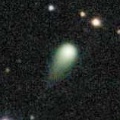
|
Now it is 11.2 mag (Nov. 27, Osamu Miyazaki). It stays bright as 10 mag for a long time until 2023 autumn. In the Northern Hemisphere, it stays observable in good condition until 2023 autumn. In the Southern Hemipshere, it stays unobservable until 2023 summer.
Date(TT) R.A. (2000) Decl. Delta r Elong. m1 Best Time(A, h)
Nov. 26 11 11.50 70 59.4 2.480 2.889 104 10.6 5:15 (193, 52)
Dec. 3 11 4.16 75 1.5 2.358 2.841 109 10.4 5:21 (186, 50)
|
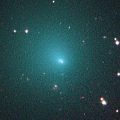
|
Now it is very bright as 10.4 mag (Nov. 23, Chris Wyatt). It stays 10 mag until November. In the Northern Hemisphere, it becomes unobservable soon. In the Southern Hemisphere, it becomes unobservable temporarily from December to January.
Date(TT) R.A. (2000) Decl. Delta r Elong. m1 Best Time(A, h)
Nov. 26 19 38.62 -39 44.3 2.060 1.595 48 10.7 18:18 ( 33, 5)
Dec. 3 19 34.16 -39 16.4 2.193 1.596 41 10.8 18:18 ( 38, 1)
|
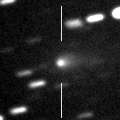
|
Now it is 13.4 mag (Nov. 26, Toshihiko Ikemura, Hirohisa Sato). It stays bright as 11-12 mag until January, and it is observable in excellent condition. It is a bit fainter than this ephemeris.
Date(TT) R.A. (2000) Decl. Delta r Elong. m1 Best Time(A, h)
Nov. 26 8 28.16 7 44.7 1.173 1.829 115 11.6 4:10 ( 0, 63)
Dec. 3 8 34.68 7 30.2 1.119 1.831 120 11.5 3:49 ( 0, 62)
|
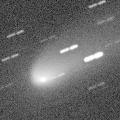
|
Now it is 11.2 mag (Nov. 25, Michael Jager). Appearing in the morning sky also in the Southern Hemisphere. It stays 11-12 mag until spring.
Date(TT) R.A. (2000) Decl. Delta r Elong. m1 Best Time(A, h)
Nov. 26 12 52.52 -4 15.7 2.063 1.610 49 11.5 5:15 (300, 29)
Dec. 3 13 11.89 -6 3.8 2.017 1.603 51 11.5 5:21 (304, 30)
|

|
It brightened up to 8.3 mag in last winter (Jan. 6, Toshiyuki Takahashi). Now it is fading. But it is bright as 11.8 mag still now (Nov. 26, Osamu Miyazaki).
Date(TT) R.A. (2000) Decl. Delta r Elong. m1 Best Time(A, h)
Nov. 26 9 59.66 -23 37.1 4.573 4.560 83 11.7 5:15 (353, 31)
Dec. 3 10 0.44 -25 6.8 4.522 4.598 88 11.7 5:14 ( 0, 30)
|

|
Now it is 13.4 mag (Nov. 12, Thomas Lehmann). It is expected to brighten up to 11 mag in 2023. In the Southern Hemisphere, it stays observable in good condition for a long time, although it becomes unobservable temporarily from November to January. In the Northern Hemisphere, it is not observable until 2024 autumn.
Date(TT) R.A. (2000) Decl. Delta r Elong. m1 Best Time(A, h)
Nov. 26 17 49.80 -19 18.0 4.335 3.462 24 12.2 18:18 ( 64, 3)
Dec. 3 17 56.02 -20 30.2 4.350 3.432 18 12.2 18:18 ( 66, -2)
|
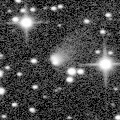
|
Now it is 13.6 mag (Nov. 23, Chris Wyatt). It stays bright as 12 mag until next summer. In the Northern Hemisphere, it stays observable in good condition until 2023 spring. In the Southern Hemisphere, it stays observable in good condition for a long time after this. It is fainter than this ephemeris recently.
Date(TT) R.A. (2000) Decl. Delta r Elong. m1 Best Time(A, h)
Nov. 26 4 27.19 13 58.2 1.752 2.732 171 12.6 0:10 ( 0, 69)
Dec. 3 4 15.55 10 28.4 1.709 2.680 167 12.4 23:26 ( 0, 65)
|
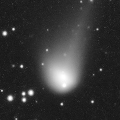
|
Now it is bright as 12.9 mag (Nov. 21, Ken-ichi Kadota). It stays 12 mag for a while. It stays observable in good condition for a while after this. It will be observable after January also in the Southern Hemisphere.
Date(TT) R.A. (2000) Decl. Delta r Elong. m1 Best Time(A, h)
Nov. 26 14 31.41 -2 36.6 5.305 4.470 29 12.8 5:15 (281, 11)
Dec. 3 14 38.71 -2 22.2 5.266 4.489 34 12.8 5:21 (285, 16)
|
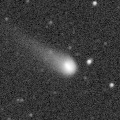
|
Now it is 13.2 mag (Nov. 16, Ken-ichi Kadota). It is expected to brighten up to 12 mag in 2023. In the Northern Hemisphere, it stays observable in good condition for a long time, although it became unobservable temporarily in October. In the Southern Hemisphere, it is not observable until mid December. But it will be observable in good condition in 2023.
Date(TT) R.A. (2000) Decl. Delta r Elong. m1 Best Time(A, h)
Nov. 26 13 49.81 7 36.1 4.443 3.792 43 13.1 5:15 (279, 26)
Dec. 3 13 51.24 6 44.9 4.340 3.774 49 13.0 5:21 (285, 31)
|

|
It brightened in major outburst in late November. Now it is very bright as 11.3 mag (Nov. 27, Jose Guilherme de S. Aguiar).
Date(TT) R.A. (2000) Decl. Delta r Elong. m1 Best Time(A, h)
Nov. 26 6 54.36 29 19.1 5.247 6.046 141 13.5 2:37 ( 0, 84)
Dec. 3 6 51.70 29 22.7 5.185 6.048 148 13.4 2:07 ( 0, 84)
|
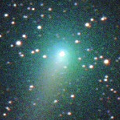
|
It brightened up to 9.3 mag in early summer (June 5, Chris Wyatt). Now it is fading. It has already faded down to 15.6 mag (Nov. 26, G. Duszanowicz, J. Camarasa). In the Southen Hemisphere, it stays observable in good condition for a long time. It became observable also in the Northern Hemisphere. But it stays locating low for a while.
Date(TT) R.A. (2000) Decl. Delta r Elong. m1 Best Time(A, h)
Nov. 26 9 46.97 -43 24.3 2.731 2.722 79 13.6 5:15 (358, 11)
Dec. 3 9 36.56 -43 47.4 2.692 2.783 84 13.7 4:51 ( 0, 11)
|
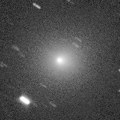
|
Brightening very rapidly. Now it is very bright as 11.4 mag (Nov. 25, Michael Jager). It is expected to brighten up to 11-12 mag in winter. In the Northern Hemisphere, it will be observable in good condition after this. In the Southern Hemisphere, it is not observable until 2023 June.
Date(TT) R.A. (2000) Decl. Delta r Elong. m1 Best Time(A, h)
Nov. 26 13 26.15 28 54.6 2.299 2.046 62 13.9 5:15 (260, 41)
Dec. 3 13 43.64 31 45.3 2.155 2.001 67 13.7 5:21 (258, 45)
|
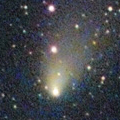
|
It brightened up to 10.4 mag from June to July (July 22, Ken-ichi Kadota). Now it is fading. Appearing in the morning sky in the Souther Hemisphere. However, now it is not detected, fainter than 17.5 mag (Nov. 29, Martin Masek). It will never be observable again in the Northern Hemisphere.
Date(TT) R.A. (2000) Decl. Delta r Elong. m1 Best Time(A, h)
Nov. 26 15 27.11 -59 7.6 2.780 2.105 38 13.7 5:15 (324,-29)
Dec. 3 15 57.52 -60 58.2 2.856 2.187 39 14.0 5:21 (326,-29)
|
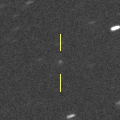
|
It will brighten up to 13 mag in winter. But the condition is bad. It is not observable until February in the Southern Hemisphere, or until May in the Northern Hemisphere.
Date(TT) R.A. (2000) Decl. Delta r Elong. m1 Best Time(A, h)
Nov. 26 15 43.96 -19 18.0 2.661 1.681 5 14.4 5:15 (285,-13)
Dec. 3 16 4.51 -20 43.5 2.634 1.661 7 14.2 5:21 (288,-11)
|
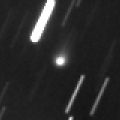
|
Now it is 14.5 mag (Nov. 25, Chris Wyatt). It stays 14 mag in 2023. In the Southern Hemisphere, it stays observable in good condition for a long time. It locates somewhat low in the Northern Hemisphere.
Date(TT) R.A. (2000) Decl. Delta r Elong. m1 Best Time(A, h)
Nov. 26 5 9.78 -24 13.7 2.928 3.666 132 14.5 0:53 ( 0, 31)
Dec. 3 4 52.39 -24 29.7 2.888 3.636 133 14.4 0:08 ( 0, 31)
|

|
Now it is 14.7 mag (Nov. 23, Chris Wyatt). It stays observable at 13-14 mag for a while. It locates low in the Northern Hemisphere.
Date(TT) R.A. (2000) Decl. Delta r Elong. m1 Best Time(A, h)
Nov. 26 19 57.20 -27 58.6 3.615 3.119 52 14.7 18:18 ( 36, 17)
Dec. 3 20 7.79 -27 23.9 3.696 3.126 48 14.7 18:18 ( 40, 15)
|
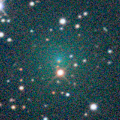
|
Brightening very rapidly. Now it is 14.5 mag (Nov. 17, Michael Jager). It brightens up to 13 mag in January. In the Northern Hemisphere, it stays observable in excellent condition. In the Southern Hemisphere, it is not observable until February.
Date(TT) R.A. (2000) Decl. Delta r Elong. m1 Best Time(A, h)
Nov. 26 18 56.00 67 22.3 1.081 1.509 93 15.0 18:18 (153, 45)
Dec. 3 19 3.17 67 53.5 1.017 1.464 93 14.7 18:18 (153, 43)
|

|
Now it is 15.1 mag (Oct. 26, Thomas Lehmann). The brightness evolution is slower than originally expected. It stays 14-15 mag for a long time. Now it is not observable. It will be observable in early January in the Northern Hemisphere, or in early February in the Southern Hemisphere.
Date(TT) R.A. (2000) Decl. Delta r Elong. m1 Best Time(A, h)
Nov. 26 17 18.04 -18 18.0 3.967 3.039 17 14.9 18:18 ( 69, -3)
Dec. 3 17 23.12 -17 9.9 4.012 3.056 12 14.9 18:18 ( 73, -6)
|
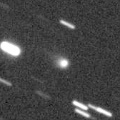
|
Now it is 14.5 mag (Nov. 23, Chris Wyatt). It is expected to brighten up to 8 mag in 2023 July. In 2022, it stays observable in good condition while the comet will be brightening gradually.
Date(TT) R.A. (2000) Decl. Delta r Elong. m1 Best Time(A, h)
Nov. 26 1 25.15 -11 30.1 2.752 3.459 129 15.1 21:03 ( 0, 44)
Dec. 3 1 13.15 -12 19.1 2.792 3.390 119 15.0 20:24 ( 0, 43)
|
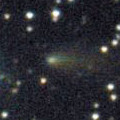
|
Now it is 15.1 mag (Nov. 25, Chris Wyatt). It stays observable in good condition at 15 mag from summer to winter. It locates somwwhat low in the Southern Hemisphere.
Date(TT) R.A. (2000) Decl. Delta r Elong. m1 Best Time(A, h)
Nov. 26 8 7.82 19 23.9 1.754 2.441 123 15.2 3:50 ( 0, 74)
Dec. 3 8 8.68 19 42.9 1.700 2.456 130 15.2 3:23 ( 0, 75)
|
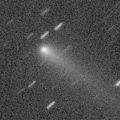
|
Now it is 14.8 mag (Nov. 24, Purple Mountain Observatory, XuYi Station). It stays 15 mag and observable in excellent condition until December.
Date(TT) R.A. (2000) Decl. Delta r Elong. m1 Best Time(A, h)
Nov. 26 2 5.17 24 39.9 1.515 2.431 152 15.3 21:44 ( 0, 80)
Dec. 3 2 1.47 25 20.1 1.566 2.438 144 15.3 21:13 ( 0, 80)
|
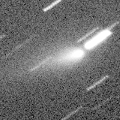
|
Outburst occured in early October. Now it is very bright as 11.8 mag (Nov. 23, Chris Wyatt). It stays observable in good condition in the Southern Hemisphere. It locates low in the Northern Hemisphere.
Date(TT) R.A. (2000) Decl. Delta r Elong. m1 Best Time(A, h)
Nov. 26 21 34.73 -26 14.5 1.512 1.567 74 15.3 18:18 ( 16, 27)
Dec. 3 21 57.00 -23 51.8 1.621 1.632 72 15.7 18:18 ( 18, 29)
|

|
Now it is 14.9 mag (Nov. 25, Chris Wyatt). It was expected to brighten up to 13 mag in spring. But actually, it was fainter than originally expected. In the Southern Hemisphere, it stays observable in good condition for a long time. In the Northern Hemisphere, it stays extremely low for a while.
Date(TT) R.A. (2000) Decl. Delta r Elong. m1 Best Time(A, h)
Nov. 26 3 47.09 -51 54.5 3.074 3.495 107 15.5 23:23 ( 0, 3)
Dec. 3 3 27.21 -50 19.4 3.122 3.525 106 15.5 22:36 ( 0, 5)
|
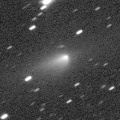
|
It brightened up to 12.7 mag in early 2022 (Feb. 27, Toshihiko Ikemura, Hirohisa Sato). Now it is fading. Now it is not observable. It will be observable agin at 16 mag in January in the Southern Hemisphere, or in February in the Northern Hemisphere.
Date(TT) R.A. (2000) Decl. Delta r Elong. m1 Best Time(A, h)
Nov. 26 15 49.64 -21 39.4 3.364 2.380 3 15.5 5:15 (286,-15)
Dec. 3 16 4.52 -22 27.4 3.373 2.398 7 15.6 5:21 (289,-12)
|
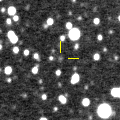
|
Now it is 15.8 mag (Nov. 21, Ken-ichi Kadota). It will brighten up to 13 mag from 2024 to 2025.
Date(TT) R.A. (2000) Decl. Delta r Elong. m1 Best Time(A, h)
Nov. 26 9 14.03 -35 9.0 6.929 6.965 88 15.7 4:55 ( 0, 20)
Dec. 3 9 14.67 -35 53.9 6.822 6.931 92 15.6 4:29 ( 0, 19)
|
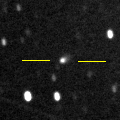
|
Now it is 15.6 mag (Nov. 29, ATLAS Chile). It is expected to brighten up to 7 mag in early 2024. In the Southern Hemisphere, it stays observable in good condition for a long time. In the Northern Hemisphere, it stays low in 2022.
Date(TT) R.A. (2000) Decl. Delta r Elong. m1 Best Time(A, h)
Nov. 26 6 9.48 -35 57.6 4.900 5.407 116 15.8 1:51 ( 0, 19)
Dec. 3 6 5.10 -36 46.3 4.815 5.343 117 15.7 1:20 ( 0, 18)
|
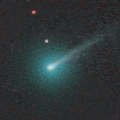
|
It brightened rapidly up to 12.4 mag in early October (Oct. 2, Michael Jager). Then it became fainter a bit, 13.6 mag (Oct. 30, Ken-ichi Kadota). Although it is a tiny comet, it approached to Sun down to 0.63 a.u. on Oct. 25. It is not observable after this.
Date(TT) R.A. (2000) Decl. Delta r Elong. m1 Best Time(A, h)
Nov. 26 15 31.70 -5 36.5 1.809 0.915 17 15.9 5:15 (275, -3)
Dec. 3 15 50.76 -9 18.3 1.921 1.016 16 16.5 5:21 (280, -2)
|
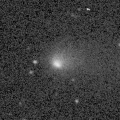
|
Now it is 15.4 mag (Nov. 26, Toshihiko Ikemura, Hirohisa Sato). It stays 15 mag until November, and it stays observable in good condition.
Date(TT) R.A. (2000) Decl. Delta r Elong. m1 Best Time(A, h)
Nov. 26 1 17.02 -0 17.3 1.336 2.141 133 15.9 20:56 ( 0, 55)
Dec. 3 1 19.12 0 2.2 1.401 2.148 127 16.1 20:31 ( 0, 55)
|
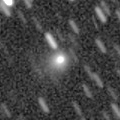
|
It brightened by 6 mag in outburst in early August up to 14.6 mag (Aug. 13, ATLAS-MLO, Mauna Loa). It is bright as 16.2 mag still now (Nov. 18, Toshihiko Ikemura, Hirohisa Sato). It seems to stay 16 mag for a while. It stays observable in good condition for a while.
Date(TT) R.A. (2000) Decl. Delta r Elong. m1 Best Time(A, h)
Nov. 26 20 36.87 -7 54.9 1.933 1.787 66 16.0 18:18 ( 40, 39)
Dec. 3 20 54.34 -8 21.5 1.973 1.768 63 16.0 18:18 ( 42, 37)
|
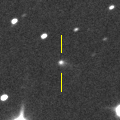
|
Now it is 15.6 mag (Nov. 18, Toshihiko Ikemura, Hirohisa Sato). It stays 16 mag and observable in good condition until spring.
Date(TT) R.A. (2000) Decl. Delta r Elong. m1 Best Time(A, h)
Nov. 26 9 22.96 17 7.6 3.043 3.443 105 16.1 5:05 ( 0, 72)
Dec. 3 9 27.30 17 29.8 2.939 3.430 111 16.0 4:41 ( 0, 72)
|
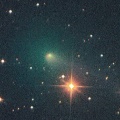
|
Now it is 14.8 mag (Nov. 19, W. Pei). It stays observable in good condition after this. But it will be fading gradually after this.
Date(TT) R.A. (2000) Decl. Delta r Elong. m1 Best Time(A, h)
Nov. 26 0 46.36 -1 55.9 2.040 2.741 126 16.0 20:26 ( 0, 53)
Dec. 3 0 47.08 -1 34.4 2.161 2.783 119 16.3 19:59 ( 0, 54)
|
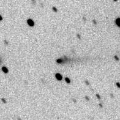
|
Now it is 16.3 mag (Nov. 13, ATLAS South Africa). It will be observable at 16-17 mag in excellent condition from autumn to winter.
Date(TT) R.A. (2000) Decl. Delta r Elong. m1 Best Time(A, h)
Nov. 26 4 20.99 -0 44.6 2.541 3.476 158 16.1 0:04 ( 0, 54)
Dec. 3 4 16.71 -1 10.7 2.553 3.479 156 16.1 23:27 ( 0, 54)
|
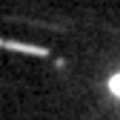
|
Now it is 16.8 mag (Nov. 10, Ken-ichi Kadota). It will brighten rapidly up to 14 mag in spring. In the Southern Hemisphere, it will appear in the morning sky in December, and it will be observable in excellent condition in spring. In the Northern Hemisphere, it is observable in good condition in winter, but it becomes somewhat low in spring.
Date(TT) R.A. (2000) Decl. Delta r Elong. m1 Best Time(A, h)
Nov. 26 12 57.07 2 4.7 2.987 2.494 51 16.3 5:15 (293, 33)
Dec. 3 13 7.15 0 30.2 2.901 2.480 55 16.2 5:21 (299, 36)
|

|
It was observed at 15 mag from 2021 to 2022. Now it is fading. In the Southern Hemisphere, it stays observable in excellent condition for a long time, although it became extremely low temporarily in November. In the Northern Hemiphere, it is not observable after this.
Date(TT) R.A. (2000) Decl. Delta r Elong. m1 Best Time(A, h)
Nov. 26 14 58.68 -54 29.4 6.568 5.798 35 16.2 5:15 (321,-23)
Dec. 3 15 2.52 -55 21.6 6.575 5.825 37 16.2 5:21 (324,-20)
|

|
Now it is 19.8 mag (Oct. 7, J. L. Virlichie, P. Traverse, H. Roy, G. Houdin). It will approach to Sun down to 0.1 a.u. on Jan. 31. In the Northern Hemisphere, it will appear in the morning sky at 9 mag in mid February, then it stays observable while the comet will be fading. In the Southern Hemisphere, it stays observable for a long time, although it is not observable from mid January to mid February.
Date(TT) R.A. (2000) Decl. Delta r Elong. m1 Best Time(A, h)
Nov. 26 18 31.14 -47 0.1 2.212 1.579 39 16.8 18:18 ( 37, -9)
Dec. 3 18 44.05 -46 22.4 2.150 1.466 35 16.4 18:18 ( 40,-10)
|
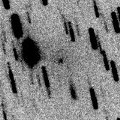
|
Now it is 17.6 mag (Oct. 25, Michael Jager). Tiny comet, but it will approach to Sun down to 0.8 a.u. in January, and to Earth down to 0.6 a.u. in March. It will brighten up to 14 mag from January to March. In the Southern Hemisphere, it stays observable in good condition for a long time. In the Northern Hemisphere, it is observable only until early Decemebr. Then it will become observable again in early March.
Date(TT) R.A. (2000) Decl. Delta r Elong. m1 Best Time(A, h)
Nov. 26 20 20.11 -31 20.7 1.553 1.316 57 16.6 18:18 ( 30, 16)
Dec. 3 20 26.70 -34 25.4 1.564 1.228 51 16.4 18:18 ( 32, 11)
|
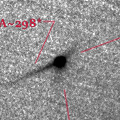
|
Due to the DART spacecraft impact to its satellite Dimorphos on Sept. 26, the cometary activity was detected. It brightened up to 12.9 mag (Sept. 28, John Drummond). It is fading after that. It has already faded down to 15.9 mag (Oct. 29, Katsumi Yoshimoto). It stays observable in good condition for a while.
Date(TT) R.A. (2000) Decl. Delta r Elong. m1 Best Time(A, h)
Nov. 26 8 22.82 18 34.7 0.163 1.077 119 16.5 4:05 ( 0, 73)
Dec. 3 8 22.05 21 16.8 0.178 1.104 127 16.5 3:37 ( 0, 76)
|
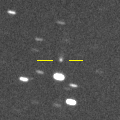
|
Now it is 17.7 mag (July 9, ATLAS Chile). It will brighten up to 16 mag in 2023. In the Southern Hemisphere, it stays observable in good condition for a long time, although it became low temporarily from August to October. In the Northern Hemisphere, it will never be observable again.
Date(TT) R.A. (2000) Decl. Delta r Elong. m1 Best Time(A, h)
Nov. 26 13 11.58 -49 53.0 3.950 3.324 44 16.7 5:15 (328, -8)
Dec. 3 13 25.56 -51 56.9 3.902 3.310 47 16.7 5:21 (332, -7)
|
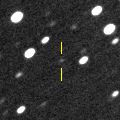
|
Now it is 17.0 mag (Nov. 16, Ken-ichi Kadota). It is expected to brighten up to 12-13 mag from 2024 to 2025.
Date(TT) R.A. (2000) Decl. Delta r Elong. m1 Best Time(A, h)
Nov. 26 10 34.14 -19 41.4 6.785 6.628 76 16.9 5:15 (343, 33)
Dec. 3 10 33.29 -19 51.8 6.628 6.584 83 16.8 5:21 (352, 35)
|
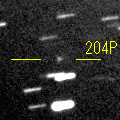
|
Now it is 17.3 mag (Nov. 26, ATLAS-HKO, Haleakala). It will brighten rapidly, and it will be observable at 16 mag in good condition in winter.
Date(TT) R.A. (2000) Decl. Delta r Elong. m1 Best Time(A, h)
Nov. 26 9 34.79 14 34.4 1.355 1.836 102 17.0 5:15 (359, 69)
Dec. 3 9 45.40 14 16.6 1.296 1.840 106 16.8 4:59 ( 0, 69)
|
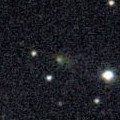
|
Now it is 16.4 mag (Nov. 5, Hirohisa Sato). It will be observable at 16-17 mag in good condition from summer to autumn.
Date(TT) R.A. (2000) Decl. Delta r Elong. m1 Best Time(A, h)
Nov. 26 3 5.19 24 56.1 1.678 2.645 165 16.9 22:44 ( 0, 80)
Dec. 3 3 0.57 24 17.1 1.733 2.673 158 17.1 22:12 ( 0, 79)
|

|
It brightened up to 14 mag in 2021. Now it is fading. It has already faded down to 16.9 mag (Nov. 21, Toshihiko Ikemura, Hirohisa Sato). It is observable at 16-17 mag in 2022.
Date(TT) R.A. (2000) Decl. Delta r Elong. m1 Best Time(A, h)
Nov. 26 23 16.24 15 1.4 6.076 6.503 111 17.0 18:56 ( 0, 70)
Dec. 3 23 16.13 15 4.6 6.220 6.542 104 17.1 18:28 ( 0, 70)
|
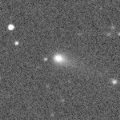
|
Now it is 17.1 mag (Nov. 21, Toshihiko Ikemura, Hirohisa Sato). It continued brightening even after the perihelion passage. It stays observable at 16 mag in good condition for a while.
Date(TT) R.A. (2000) Decl. Delta r Elong. m1 Best Time(A, h)
Nov. 26 23 1.07 -3 32.9 4.102 4.408 101 17.1 18:41 ( 0, 52)
Dec. 3 23 3.73 -3 22.7 4.221 4.422 95 17.2 18:18 ( 1, 52)
|

|
It brightened very rapidly up to 15.5 mag from last autumn to last winter (Nov. 2, 2021, Toshihiko Ikemura, Hirohisa Sato). Now it is fading slowly. It has already faded down to 16.3 mag (Nov. 18, Toshihiko Ikemura, Hirohisa Sato).
Date(TT) R.A. (2000) Decl. Delta r Elong. m1 Best Time(A, h)
Nov. 26 6 45.31 10 20.3 3.572 4.376 140 17.1 2:28 ( 0, 65)
Dec. 3 6 42.55 10 2.7 3.534 4.395 147 17.1 1:57 ( 0, 65)
|
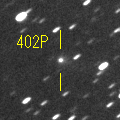
|
It brightened up to 15.3 mag in last winter (Jan. 12, H. Nohara). Now it is fading. It has already faded down to 17.4 mag (Nov. 5, Ken-ichi Kadota). It will be observable at 17 mag in good condition in next winter. It locates low in the Southern Hemisphere.
Date(TT) R.A. (2000) Decl. Delta r Elong. m1 Best Time(A, h)
Nov. 26 10 18.22 19 16.5 4.213 4.392 93 17.2 5:15 (325, 71)
Dec. 3 10 21.19 19 42.9 4.123 4.409 100 17.1 5:21 (347, 74)
|

|
Now it is 17.0 mag (Nov. 9, A. Diepvens). Fading slowly. In the Northern Hemisphere, it stays observable in good condition for a long time. In the Southern Hemisphere, it is not observable after this.
Date(TT) R.A. (2000) Decl. Delta r Elong. m1 Best Time(A, h)
Nov. 26 17 30.42 62 41.3 9.564 9.532 85 17.2 18:18 (146, 36)
Dec. 3 17 34.90 62 44.7 9.573 9.548 85 17.2 18:18 (147, 34)
|

|
Now it is 16.2 mag (Nov. 21, Toshihiko Ikemura, Hirohisa Sato). It brightened up to 14 mag from 2020 to 2021. Now it is fading slowly. It is observable at 16-17 mag in 2022.
Date(TT) R.A. (2000) Decl. Delta r Elong. m1 Best Time(A, h)
Nov. 26 0 4.23 -18 10.9 3.683 4.115 109 17.2 19:44 ( 0, 37)
Dec. 3 0 4.72 -17 32.2 3.798 4.131 102 17.3 19:17 ( 0, 38)
|
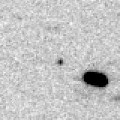
|
Now it is 17.0 mag (Nov. 18, Toshihiko Ikemura, Hirohisa Sato). It stays observable at 16 mag for a long time from early 2023 to early 2024. In the Northern Hemisphere, it is observable only until 2023 spring.
Date(TT) R.A. (2000) Decl. Delta r Elong. m1 Best Time(A, h)
Nov. 26 10 34.06 5 41.8 4.546 4.573 85 17.4 5:15 (331, 57)
Dec. 3 10 33.10 4 41.7 4.391 4.539 92 17.3 5:21 (347, 59)
|
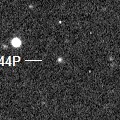
|
Now it is 17.4 mag (Nov. 18, Toshihiko Ikemura, Hirohisa Sato). It is observable at 17 mag in good condition in winter. It locates somewhat low in the Southern Hemisphere.
Date(TT) R.A. (2000) Decl. Delta r Elong. m1 Best Time(A, h)
Nov. 26 6 27.41 26 11.1 3.055 3.921 147 17.3 2:10 ( 0, 81)
Dec. 3 6 23.93 26 15.8 3.006 3.921 154 17.3 1:39 ( 0, 81)
|
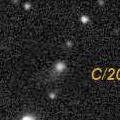
|
It stays 17 mag and observable in good condition for a long time until 2023 summer.
Date(TT) R.A. (2000) Decl. Delta r Elong. m1 Best Time(A, h)
Nov. 26 13 34.20 3 35.8 9.529 8.851 44 17.3 5:15 (285, 26)
Dec. 3 13 35.07 3 42.2 9.441 8.855 51 17.3 5:21 (291, 33)
|
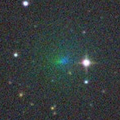
|
Brightened rapidly. It brightened up to 14.0 mag in early September (Sept. 2, Michael Jager). Now it is 16.0 mag (Sept. 26, Ken-ichi Kadota). It will be fading after this. In the Northern Hemisphere, it stays observable for a long time, although it becomes extremely low in November. It is not observable after this in the Southern Hemisphere.
Date(TT) R.A. (2000) Decl. Delta r Elong. m1 Best Time(A, h)
Nov. 26 15 18.78 22 13.6 2.341 1.778 44 17.3 5:15 (254, 15)
Dec. 3 15 19.02 23 40.8 2.302 1.821 49 17.5 5:21 (256, 23)
|

|
It brightened up to 14.2 mag in 2021 summer (July 18, 2021, Taras Prystavski). Now it is fading. It has already faded down to 16.9 mag (Nov. 18, Katsumi Yoshimoto). In the Southern Hemisphere, it stays observable in good condition for a long time. It locates somewhat low in the Northern Hemisphere.
Date(TT) R.A. (2000) Decl. Delta r Elong. m1 Best Time(A, h)
Nov. 26 1 20.89 -23 36.9 5.201 5.760 120 17.4 21:00 ( 0, 32)
Dec. 3 1 18.27 -22 47.5 5.328 5.804 114 17.4 20:30 ( 0, 32)
|
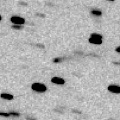
|
Now it is 17.6 mag (Nov. 2, ATLAS-MLO, Mauna Loa). In the Northern Hemisphere, it stays observable at 17 mag in good condition for a long time until winter. In the Southern Hemisphere, it stays extremely low for a long time.
Date(TT) R.A. (2000) Decl. Delta r Elong. m1 Best Time(A, h)
Nov. 26 8 17.55 49 33.2 2.316 2.972 123 17.4 4:00 (180, 76)
Dec. 3 8 18.46 50 1.1 2.284 2.998 128 17.4 3:33 (180, 75)
|
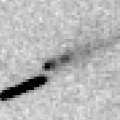
|
It brightened up to 16.1 mag in autumn (Sept. 23, Michael Jager). Then it is fading very rapidly. It has already faded down to 17.9 mag (Oct. 28, Ken-ichi Kadota). It will be getting higher after this also in the Southern Hemisphere.
Date(TT) R.A. (2000) Decl. Delta r Elong. m1 Best Time(A, h)
Nov. 26 10 42.49 3 12.4 1.583 1.753 82 17.4 5:15 (330, 54)
Dec. 3 10 51.94 1 9.9 1.546 1.784 86 17.5 5:21 (340, 55)
|
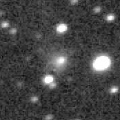
|
Now it is 18.2 mag (Nov. 21, Toshihiko Ikemura, Hirohisa Sato). It stayed bright for a while even after the perihelion passage, but it will be fading after this. It will be fainter than 18 mag in winter.
Date(TT) R.A. (2000) Decl. Delta r Elong. m1 Best Time(A, h)
Nov. 26 21 14.07 -2 40.0 7.540 7.381 77 17.5 18:18 ( 32, 48)
Dec. 3 21 15.06 -3 9.8 7.685 7.409 70 17.6 18:18 ( 40, 44)
|
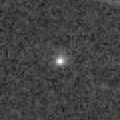
|
Now it is 16.8 mag (Nov. 18, Toshihiko Ikemura, Hirohisa Sato). It stays observable at 17-18 mag until next summer. It may be brighter than this ephemeris.
Date(TT) R.A. (2000) Decl. Delta r Elong. m1 Best Time(A, h)
Nov. 26 21 21.08 -13 27.3 1.846 1.856 75 17.5 18:18 ( 24, 38)
Dec. 3 21 11.27 -12 42.5 1.979 1.816 65 17.6 18:18 ( 35, 35)
|
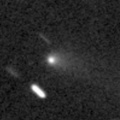
|
Now it is 17.5 mag (Nov. 21, Toshihiko Ikemura, Hirohisa Sato). Now it is fading. It stays 13-14 mag for a while. It is observable in excellent condition in the Southern Hemisphere. It locates somewhat low in the Northern Hemisphere.
Date(TT) R.A. (2000) Decl. Delta r Elong. m1 Best Time(A, h)
Nov. 26 22 39.39 -20 9.3 2.546 2.737 90 17.6 18:19 ( 0, 35)
Dec. 3 22 45.68 -19 2.1 2.677 2.775 85 17.8 18:18 ( 6, 36)
|

|
Now it is 17.6 mag (Nov. 14, X. Gao, Q.-Z. Ye). It stays observable at 17-18 mag in 2022. It locates somewhat low in the Southern Hemisphere.
Date(TT) R.A. (2000) Decl. Delta r Elong. m1 Best Time(A, h)
Nov. 26 0 41.24 20 35.6 4.909 5.623 132 17.7 20:20 ( 0, 76)
Dec. 3 0 35.32 19 37.2 5.025 5.639 124 17.7 19:47 ( 0, 75)
|

|
It brightened up to 12.3 mag from spring to summer in 2021 (June 15, 2021, Marco Goiato). Now it is fading. It has already faded down to 18.2 mag (Nov. 21, D. Buczynski). It will be fainter than 18 mag in January.
Date(TT) R.A. (2000) Decl. Delta r Elong. m1 Best Time(A, h)
Nov. 26 12 42.84 31 11.8 6.379 6.133 71 17.7 5:15 (262, 51)
Dec. 3 12 43.94 31 55.7 6.320 6.179 77 17.7 5:21 (264, 57)
|
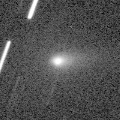
|
It brightened rapidly as predicted, and it brightened up to 14.0 mag in September (Sept. 22, Michael Jager). Now it is fading. It has already faded down to 16.6 mag (Nov. 10, ATLAS Chile). It will be fainter than 18 mag in December.
Date(TT) R.A. (2000) Decl. Delta r Elong. m1 Best Time(A, h)
Nov. 26 2 16.73 -39 34.8 1.124 1.776 114 17.7 21:56 ( 0, 16)
Dec. 3 2 19.18 -38 43.4 1.201 1.810 111 18.1 21:31 ( 0, 16)
|
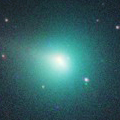
|
It brightened up to 8.8 mag from last winter to early spring (Jan. 31, Chris Wyatt). Now it is fading. Appearing in the morning sky. It will be fainter than 18 mag in December.
Date(TT) R.A. (2000) Decl. Delta r Elong. m1 Best Time(A, h)
Nov. 26 13 56.57 11 58.5 3.762 3.151 45 17.8 5:15 (274, 27)
Dec. 3 14 4.54 11 31.0 3.740 3.196 49 17.8 5:21 (278, 32)
|
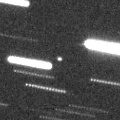
|
Now it is 17.0 mag (Nov. 26, Toshihiko Ikemura, Hirohisa Sato). In 2022, it stays observable at 17 mag for a long time.
Date(TT) R.A. (2000) Decl. Delta r Elong. m1 Best Time(A, h)
Nov. 26 8 23.62 19 3.8 0.784 1.535 119 17.8 4:06 ( 0, 74)
Dec. 3 8 17.72 19 1.3 0.786 1.596 128 17.8 3:32 ( 0, 74)
|
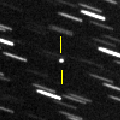
|
It approached to Sun down to 0.14 a.u. on May 15. But it was not observable around that time. In the Northern Hemisphere, it stays observable at 17-18 mag in good condition from July to November. In the Southern Hemisphere, it stays extremely low.
Date(TT) R.A. (2000) Decl. Delta r Elong. m1 Best Time(A, h)
Nov. 26 1 7.27 33 39.1 1.463 2.299 138 17.8 20:46 ( 0, 89)
Dec. 3 0 59.88 31 18.8 1.547 2.320 131 18.0 20:11 ( 0, 86)
|
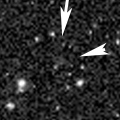
|
Now it is 17.0 mag (Nov. 24, iTelescope Observatory, Siding Spring). Very far object. It stays 18 mag for a long time from 2021 to 2026. In the Southern Hemisphere, it stays observable in good condition for a long time. In the Northern Hemisphere, it is not observable at all.
Date(TT) R.A. (2000) Decl. Delta r Elong. m1 Best Time(A, h)
Nov. 26 7 54.56 -74 9.2 10.642 10.485 78 17.8 3:35 ( 0,-19)
Dec. 3 7 44.86 -74 49.5 10.629 10.479 78 17.8 2:58 ( 0,-20)
|
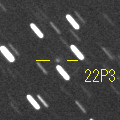
|
Now it is 17.7 mag (Nov. 18, Toshihiko Ikemura, Hirohisa Sato). In the Northern Hemisphere, it is observable at 17-18 mag in excellent condition in autumn. It is not observable in the Southern Hemisphere.
Date(TT) R.A. (2000) Decl. Delta r Elong. m1 Best Time(A, h)
Nov. 26 8 30.10 63 25.9 2.253 2.867 119 17.8 4:13 (180, 62)
Dec. 3 8 32.75 66 25.3 2.252 2.900 122 17.9 3:48 (180, 59)
|

|
Now it is 18.9 mag (Nov. 23, ATLAS-MLO, Mauna Loa). It is observable at 17.5 mag in good condition in winter.
Date(TT) R.A. (2000) Decl. Delta r Elong. m1 Best Time(A, h)
Nov. 26 9 1.02 2 59.2 3.116 3.520 106 18.0 4:43 ( 0, 58)
Dec. 3 9 3.08 2 16.6 3.021 3.515 112 17.9 4:17 ( 0, 57)
|
|
![]()
 C/2022 S3 ( PanSTARRS )
C/2022 S3 ( PanSTARRS ) (65803) Didymos
(65803) Didymos C/2021 C5 ( PanSTARRS )
C/2021 C5 ( PanSTARRS ) C/2022 E2 ( ATLAS )
C/2022 E2 ( ATLAS ) 204P/LINEAR-NEAT
204P/LINEAR-NEAT 44P/Reinmuth 2
44P/Reinmuth 2 C/2020 F5 ( MASTER )
C/2020 F5 ( MASTER ) 395P/2020 H1 ( Catalina-NEAT )
395P/2020 H1 ( Catalina-NEAT ) P/2021 N2 ( Fuls )
P/2021 N2 ( Fuls ) 402P/2020 Q3 ( LINEAR )
402P/2020 Q3 ( LINEAR ) C/2019 O3 ( Palomar )
C/2019 O3 ( Palomar ) 246P/NEAT
246P/NEAT C/2022 A3 ( Lemmon-ATLAS )
C/2022 A3 ( Lemmon-ATLAS ) 244P/Scotti
244P/Scotti C/2020 F2 ( ATLAS )
C/2020 F2 ( ATLAS ) C/2022 L1 ( Catalina )
C/2022 L1 ( Catalina ) C/2019 F1 ( ATLAS-Africano )
C/2019 F1 ( ATLAS-Africano ) C/2021 QM45 ( PanSTARRS )
C/2021 QM45 ( PanSTARRS ) 157P/Tritton
157P/Tritton C/2019 T3 ( ATLAS )
C/2019 T3 ( ATLAS ) C/2022 Q2 ( ATLAS )
C/2022 Q2 ( ATLAS ) 9P/Tempel 1
9P/Tempel 1 C/2020 U4 ( PanSTARRS )
C/2020 U4 ( PanSTARRS ) C/2020 J1 ( SONEAR )
C/2020 J1 ( SONEAR ) 327P/Van Ness
327P/Van Ness 19P/Borrelly
19P/Borrelly 107P/(4015) Wilson-Harrington
107P/(4015) Wilson-Harrington (3200) Phaethon
(3200) Phaethon C/2019 E3 ( ATLAS )
C/2019 E3 ( ATLAS ) C/2022 P3 ( ZTF )
C/2022 P3 ( ZTF ) P/2021 V2 ( Fuls )
P/2021 V2 ( Fuls )![]()


































































